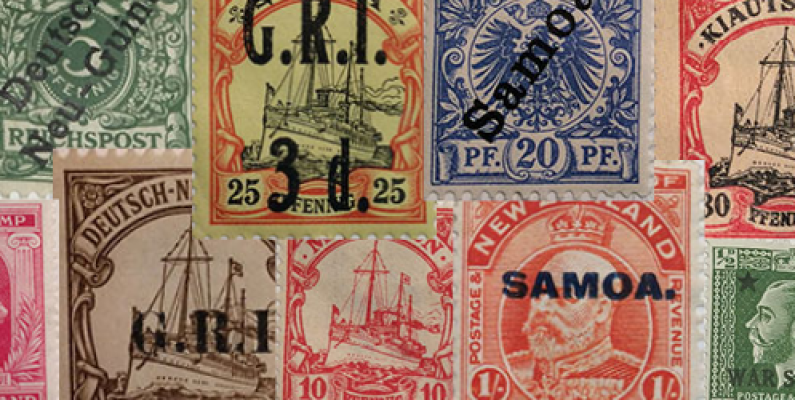
The Otago Museum stamp collection illustrates a little about some aspects of World War I in progress; in particular it offers a glimpse of the consequences for Germany and its Oceanic colonial territories. We also have examples of the 1916 stamps that Fiji, Canada, and New Zealand issued, overprinted with the words “War Stamp” or “War Tax” (image one).

Image one: 1916 New Zealand stamp overprinted with the words "War Stamp". Otago Museum Collection.
In the 19th century the major European powers extended their empires into Africa, Asia and the Pacific regions. Germany became unified in 1871 and established colonies around the world during the 1880s. All of these colonies issued postage stamps during German annexation. The most common design features a two-masted yacht with a variety of pfennig (the currency of the German Reich) and other denominations.
As its territories were invaded during the course of WWI, the German colonial issues were overprinted with the new name of the colony or the abbreviation “GRI” (for Georgius Rex Imperator, the United Kingdom sovereign).
German New Guinea included part of the island of New Guinea, the Bismarck Archipelago, and several nearby islands. German stamps overprinted with “Deutsch New Guinea” were issued in 1898 (image two) but after Australian occupation in 1914, the yacht issue appeared with a “GRI” overprint and sterling (English currency) denominations (image three).


Image two left: German New Guinea stamp overprinted with “Deutsch New Guinea”. Image three right: Yacht issue with a "GRI" overprint. Otago Museum Collection.
German influence extended north to the Mariana Islands and yacht stamps were issued there (image four).

Image four: Mariana Islands yacht stamp. Otago Museum Collection.
In 1898 China leased Kiautschou Bay territory to Germany; yacht stamps were issued (image five), and in November 1914 it was invaded by Japanese forces.

Image five: Kiautschou Bay yacht stamp. Otago Museum Collection.
In 1900, Reichpost (the German postal service) stamps overprinted “Samoa” had been issued (image six), followed in 1914 by issues of yacht designs. After British annexation the pfennig denomination stamps were overprinted with sterling values and “GRI” (image seven).


Image six left: Reichpost stamp overprinted with "Samoa". Image seven right: Pfennig denomination stamp overprinted with sterling values and “GRI”. Otago Museum Collection.
On 29 September 1914, just seven weeks after the declaration of war, a contingent of New Zealand soldiers disembarked at Apia and captured what had been German Samoa without a shot being fired. Soon after, some New Zealand stamps were issued, featuring mainly King Edward VII, together with the 1d Dominion and the Lake Wakatipu pictorial, overprinted with “Samoa” (image eight).

Image eight: New Zealand stamp featuring King Edward VII overprinted with "Samoa". Otago Museum Collection.
Surprisingly, few of the larger British Commonwealth countries commemorated the end of hostilities with stamps, but New Zealand produced a “Victory issue” in 1920 (image nine).

Image nine: 1920 New Zealand Victory Stamp. Otago Museum Collection.
